Lesson by Alysha Butler
Essay by Kate Masur, Northwestern University
Grade Level: 7–12
Number of Class Periods: 1
Primary Era: National Expansion and Reform, 1815–1860

This lesson explores the responses of free Black people to racially discriminatory laws in the early 1800s. Students will analyze a nineteenth-century portrait of James Forten, a free Black abolitionist and businessman from Philadelphia, a letter he wrote fighting a proposed law that would have required free Black people to register with local officials, and a free Black sailor’s affidavit regarding his incarceration in New Orleans. They will demonstrate their understanding through a close-reading activity, answers to critical thinking questions, and an optional Socratic seminar.
Lesson Plan Author: Alysha Butler
Historical Background Essay by: Kate Masur, Northwestern University
CCSS.ELA-LITERACY.RH.9-10.1: Cite specific textual evidence to support analysis of primary and secondary sources, attending to such features as the date and origin of the information.
CCSS.ELA-LITERACY.RH.9-10.4: Determine the meaning of words and phrases as they are used in a text, including vocabulary describing political, social, or economic aspects of history/social studies.
CCSS.ELA-LITERACY.RH.9-10.5: Analyze how a text uses structure to emphasize key points or advance an explanation or analysis.
CCSS.ELA-LITERACY.RH.9-10.6: Compare the point of view of two or more authors for how they treat the same or similar topics, including which details they include and emphasize in their respective accounts.
CCSS.ELA-LITERACY.RH.11-12.5: Analyze in detail how a complex primary source is structured, including how key sentences, paragraphs, and larger portions of the text contribute to the whole.
CCSS.ELA-LITERACY.RH.11-12.6: Evaluate authors’ differing points of view on the same historical event or issue by assessing the authors’ claims, reasoning, and evidence.
What sorts of laws made it difficult for free Black people to enjoy full citizenship rights?
How did free Black men fight racial discrimination and further the cause for civil rights in the early republic?
A Portrait of James Forten, by an unknown artist, ca. 1818
Excerpts from James Forten, Letters from a Man of Colour, on a Late Bill Before the Senate of Pennsylvania (Pennsylvania: s.n., 1813)
Excerpts from an Affidavit by Joseph Thompson, Suffolk, November 20, 1833, Boston, in David L. Child, The Despotism of Freedom; or the Tyranny and Cruelty of American Republican Slave-Masters, Shown to Be the Worst in the World; in a Speech, Delivered at the First Anniversary of the New England Anti-Slavery Society, 1833 (Boston, 1833)